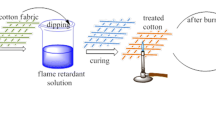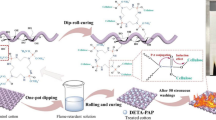Abstract
The eco-friendly flame-retardant I-type ammonium polyphosphate (I-type APP) has poor water solubility and poor durability when applied to textiles, limiting its application in the textile industry. In this study, we resolve I-type APP solubility in water and then improve its durability for cotton fabric. The resolvable APP was grafted onto cotton fabrics by the P–O–C bonds. The limiting oxygen index (LOI) values of the 30% APP-treated cotton fabric was 50.1%; after 50 laundering cycles (LCs), the LOI values still retained 28.5%. No after-flame and after-glow were observed in the vertical burning test. These experimental results imply that the APP-treated cotton fabrics have high flame retardancy and excellent durability. Scanning electron microscopy showed that the surfaces of cotton fabric before and after treatment were similar and no material was deposited on the surface. X-ray diffraction analysis demonstrated that the crystal structures of the APP-treated cotton were almost unaffected. The thermogravimetric (TG) and TG-infrared (IR) analysis indicated that the treated cotton produced phosphoric acid or polyphosphoric acid during thermal decomposition to promote the dehydration and carbonization of cellulose in favor of char form. The results of the microcalorimetry indicated that the total heat release and the peak of the heat release rate of the treated cotton were significantly lower than those of the control cotton. The whiteness indexes, tensile strengths and bending lengths of the APP-treated cotton fabric showed that it still maintained good physical properties.
Graphical abstract











Similar content being viewed by others
References
Alongi J, Ciobanu M, Malucelli G (2011) Novel flame retardant finishing systems for cotton fabrics based on phosphorus-containing compounds and silica derived from sol–gel processes. Carbohyd Polym 85:599–608
Cao XL, Yang YY, Luo H, Cai XF (2017) High efficiency intumescent flame retardancy between Hexakis (4-nitrophenoxy) cyclotriphosphazene and ammonium polyphosphate on ABS. Polym Degrad Stabil 143:259–265
Carosio F, Alongi J (2015) Few durable layers suppress cotton combustion due to the joint combination of layer by layer assembly and UV-curing. RSC Adv 5:71482–71490
Chen XL, Ma CY, Jiao CM (2016) Synergistic effects between iron-graphene and ammonium polyphosphate in flame-retardant thermoplastic polyurethane. J Therm Anal Calorim 126:633–642
Chen XL, Wang WD, Jiao CM (2017) A recycled environmental friendly flame retardant by modifying para-aramid fiber with phosphorus acid for thermoplastic polyurethane elastomer. J Hazard Mater 331:257–264
Ding HY, Huang K, Li SH, Xu LN, Xia JL, Li M (2017a) Synthesis of a novel phosphorus and nitrogen-containing bio-based polyol and its application in flame retardant polyurethane foam. J Anal Appl Pyrol 128:102–113
Ding HY, Huang K, Li SH, Xu LN, Xia JL, Li M (2017b) Flame retardancy and thermal degradation of halogen-free flame-retardant biobased polyurethane composites based on ammonium polyphosphate and aluminium hypophosphite. Polym Test 62:325–334
Dong CH, He PS, Lu Z, Wang SG, Sui SY, Liu J, Zhang L, Zhu P (2017) Preparation and properties of cotton fabrics treated with a novel antimicrobial and flame retardant containing triazine and phosphorus components. J Therm Anal Calorim 87(11):1–9
Duan DL, Ruan R, Wang YP, Liu YH, Dai LL, Zhao YF, Zhou Y, Wu QH (2018) Microwave-assisted acid pretreatment of alkali lignin: effect on characteristics and pyrolysis behavior. Bioresource Technol 251:57–62
Feng YJ, Zhou Y, Li DK, He S, Zhang FX, Zhang GX (2017) A plant-based reactive ammonium phytate for use as a.flame-retardant for cotton fabric. Carbohyd Polym 175:636–644
Feng YZ, He CG, Wen YF, Ye YS, Zhou XP, Xie XL, Mai YM (2018) Superior flame retardancy and smoke suppression of epoxy-based composites with phosphorus/nitrogen co-doped graphene. J Hazard Mater 346:140–151
Gao Y, Morisada Y, Fujii H, Liao J (2018) Dissimilar friction stir lap welding of magnesium to aluminum using plasma electrolytic oxidation interlayer. Mater Sci Eng, A 711:109–118
Gu LM, Ge Z, Huang MH, Luo YJ (2015) Halogen-free flame-retardant waterborne polyurethane with a novel cyclic structure of phosphorus–nitrogen synergistic flame retardant. J Appl Polym Sci 132(3):41288
Han YY, Zhang XX, Wu XD, Lu CH (2015) Flame retardant, heat insulating cellulose aerogels from waste cotton fabrics by in situ formation of magnesium hydroxide nanoparticles in cellulose gel nanostructures. ACS Sustainable Chem Eng 3(8):1853–1859
Jarosiewicz M, Duchnowicz P, Włuka A, Bukowska B (2017) Evaluation of the effect of brominated flame retardants on hemoglobin oxidation and hemolysis in human erythrocytes. Food Chem Toxicol 109:264–271
Jiang Y, Zhou WL, Jiang MJ, Liu PQ, Xu JJ (2017) Flame retardant study of formalized polyvinyl alcohol fiber coated with melamine formaldehyde resins and the synergistic effect of copper ions. Polym Degrad Stabil 144:331–343
Jing J, Zhang Y, Tang XL, Zhou Y, Li XN, Kandola BK (2017) Layer by layer deposition of polyethylenimine and bio based polyphosphate on ammonium polyphosphate: a novel hybrid for simultaneously improving the flame retardancy and toughness of polylactic acid. Polymer 108:361–371
Kim SJ, Jang J (2017) Synergistic UV-curable flame-retardant finish of cotton using comonomers of vinylphosphonic acid and acrylamide. Fiber Polym 18:2328–2333
Kim NL, Lin RJT, Bhattacharyya D (2015) Effects of wool fibers, ammonium polyphosphate and polymer viscosity on the flammability and mechanical performance of PP/wool composites. Polym Degrad Stabil 119:167–177
Konig A, Kroke E (2012) Flame retardancy working mechanism of methyl-DOPO and MPPP in flexible polyurethane foam. Fire Mater 36:1–15
Li LP, Hu HD, Hu HQ (2014) Effect of ammonium polyphosphate modified with 3-(methylacryloxyl) propyltrimethoxy silane on the flammability and thermal degradation of pine-needles. Polym Polym Compos 22(9):837–842
Li ZY, Jia ZG, Ni T, Li SB (2017) Green and facile synthesis of fibrous Ag/cotton composites and their catalytic properties for 4-nitrophenol reduction. Appl Surf Sci 426:160–168
Naik AD, Fontaine G, Bellayer S, Bourbigot S (2015) Salen based Schiff bases to flame retard thermoplastic polyurethane mimicking operational strategies of thermosetting resin. RSC Adv 5:48224–48235
Neugebauer F, Dreyer A, Lohmann N, Koschorreck J (2017) Determination of halogenated flame retardants by GC-API-MS/MS and GC-EI-MS: a multi-compound multi-matrix method. Anal Bioanal Chem 410(4):1375–1387
Parsa MR, Chaffee AL (2018) The effect of densification with NaOH on brown coal thermal oxidation behaviour and structure. Fuel 216:548–558
Pethsangave DA, Khose RV, Wadekar PH, Some S (2017) Deep eutectic solvent functionalized graphene composite as an extremely high potency flame retardant. ASC Appl Mater Interfaces 9:35319–35324
Poma G, Malysheva SV, Goscinny S, Malarvannan G, Voorspoels S, Covaci A, Loco JV (2018) Occurrence of selected halogenated flame retardants in Belgian foodstuff. Chemosphere 194:256–265
Price D, Horrucks AR, Akalin M, Faroq AA (1997) Influence of flame retardants on the mechanism of pyrolysis of cotton (celluIose) fabrics in air. J Anal Appl Pyrol 40–41:511–524
Qin ZL, Li DH, Lan YH, Li Q, Yang RJ (2015) Ammonium polyphosphate and silicon-containing cyclotriphosphazene: synergistic effect in flame-retarded polypropylene. Ind Eng Chem Res 54(43):10707–10713
Qiu SL, Ma C, Wang X, Zhou X, Feng XM, Yuen RKK, Hu Y (2018) Melamine-containing polyphosphazene wrapped ammonium polyphosphate: a novel multifunctional organic-inorganic hybrid flame retardant. J Hazard Mater 344:839–848
Raslan HA, Elnaggar MY, Fathy ES (2017) Flame-retardancy and physico-thermomechanical properties of irradiated ethylene propylene diene monomer inorganic composites. J Vinyl Addit Techn. https://doi.org/10.1002/vnl.21615
Ribeiro SPD, Estevao LRD, Novak C, Nascimento RSV (2011) Clays basal spacings effect on fire retardancy of polymers by TG/DTA. J Therm Anal Calorim 106:535–539
Seki Y (2018) Conductive cotton fabrics coated with Myristic acid/zinc oxide nanoparticles. Polym Plast Technol Eng 57(8):766–774
Strover LT, Malmstrom J, Stubbing LA, Brimble MA, Travas-Sejdic J (2016) Electrochemically-controlled grafting of hydrophilic brushes from conducting polymer substrates. Electrochim Acta 188:57–70
Sun LS, Qu YT, Li SX (2013) Co-microencapsulate of ammonium polyphosphate and pentaerythritol in intumescent flame-retardant coatings. J Therm Anal Calorim 111:1099–1106
Tang QB, Wang BB, Shi YQ, Song L, Hu Y (2013) Microencapsulated ammonium polyphosphate with glycidyl methacrylate shell: application to flame retardant epoxy resin. Ind Eng Chem Res 52:5640–5647
Tian XY, He W, Cui JJ, Zhang DX, Zhou WJ, Yan SP, Sun XN, Han XX, Han SS, Yue YZ (2010) Mesoporous zirconium phosphate from yeast biotemplate. J Colloid Interf Sci 343(1):344–349
Wang N, Mi L, Wu YX, Wang XZ, Fang QH (2013) Enhanced flame retardancy of natural rubber composite with addition of microencapsulated ammonium polyphosphate and MCM-41 fillers. Fire Safety J 62:281–288
Wang W, Zhang SF, Wang F, Yan YT, Li JZ, Zhang W (2016) Effect of microencapsulated ammonium polyphosphate on flame retardancy and mechanical properties of wood flour/polypropylene composites. Polym Composite 37(3):666–673
Wang F, Zhang P, Mou YR, Kang M, Liu M, Song LX, Lu A, Rong JZ (2017) Synthesis of the polyethylene glycol solid-solid phase change materials with a functionalized graphene oxide for thermal energy storage. Polym Test 63:494–504
Xu L, Jiang Y, Qiu R (2018) Parametric study and global sensitivity analysis for co-pyrolysis of rape straw and waste tire via variance-based decomposition. Bioresource Technol 247:545–552
Yang SS, Chen ZB (2018) The study on aging and degradation mechanism of ammonium polyphosphate in artificial accelerated aging. Procedia Engineering 211:906–910
Yang CQ, He QL, Lyon RE, Hu Y (2010) Investigation of the flammability of different textile fabrics using micro-scale combustion calorimetry. Polym Degrad Stabil 95:108–115
Yang ZY, Wang XW, Lei DP, Fei B, Xin JH (2012) A durable flame retardant for cellulosic fabrics. Polym Degrad Stabil 97:2467–2472
Zhang DQ, Williams BL, Shrestha SB, Nasir Z, Becher EM, Lofink BJ, Santos VH, Patel H, Peng XH, Sun LY (2017) Flame retardant and hydrophobic coatings on cotton fabrics via sol-gel and self-assembly techniques. J Colloid Interf Sci 505:892–899
Zhao XM, Guerrero FR, Llorca J, Wang DY (2016) New superefficiently flame-retardant bioplastic poly(lactic acid): flammability, thermal decomposition behavior, and tensile properties. ACS Sustain Chem Eng 4:202–209
Zhou QQ, Chen GQ, Xing TL (2018) Facile construction of robust superhydrophobic tea polyphenol/Fe@cotton fabric for self-cleaning and efficient oil–water separation. Cellulose 25(2):1513–1525
Acknowledgments
The research was supported by Chongqing postgraduate education and teaching reform major Project (NO: yjg152022), and Chongqing natural science foundation of key projects in China (Grant No: CSTC 2014 yy kfB50002).
Author information
Authors and Affiliations
Corresponding authors
Electronic supplementary material
Below is the link to the electronic supplementary material.
Rights and permissions
About this article
Cite this article
Lu, Y., Jia, Y., Zhang, G. et al. An eco-friendly intumescent flame retardant with high efficiency and durability for cotton fabric. Cellulose 25, 5389–5404 (2018). https://doi.org/10.1007/s10570-018-1930-0
Received:
Accepted:
Published:
Issue Date:
DOI: https://doi.org/10.1007/s10570-018-1930-0




